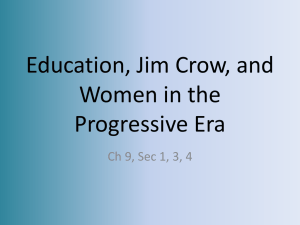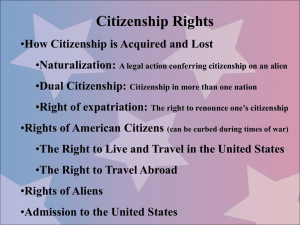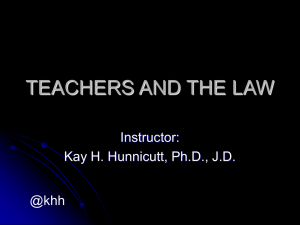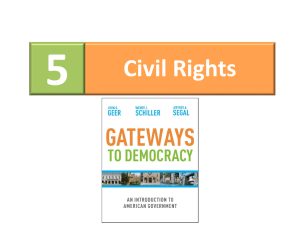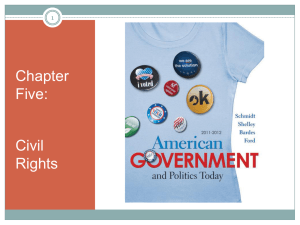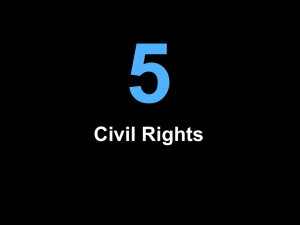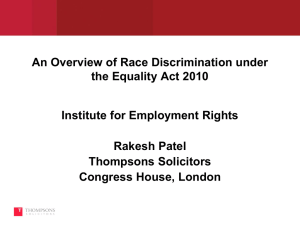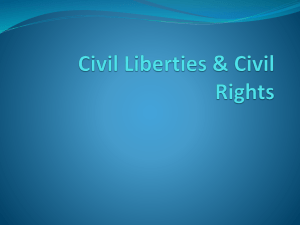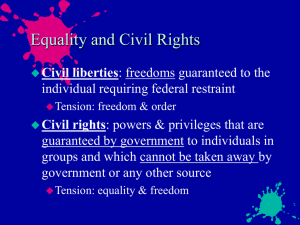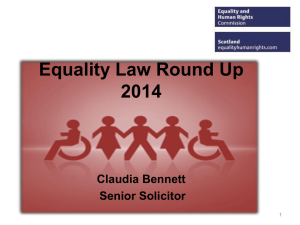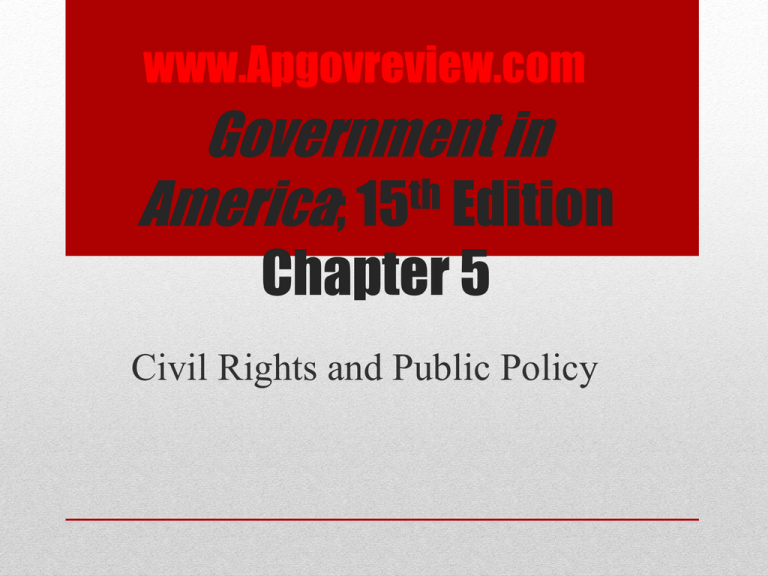
www.Apgovreview.com
Government in
th
America; 15 Edition
Chapter 5
Civil Rights and Public Policy
Politics In Action: Launching The Civil Rights
Movement
• Civil Rights – protections of individuals from arbitrary (random)
discrimination by government or people
• Debates about equality:
• Racial and ethnic discrimination – Affirmative Action
• Gender discrimination – equal rights for women is not guaranteed under
the Constitution (failed ERA)
• Age, disability, and sexual orientation discrimination
The Struggle for Equality
• Conceptions of Equality:
• Equal rights does not translate to equal rewards
• Most people favor equality of opportunity
• The Constitution and Inequality:
• Equality is only mentioned in the 14th amendment
• Forbids the denial of “equal protection of the laws”
• Laws that classify people must not be arbitrary
• Can’t focus on skin color, religion, etc.
• However, classifying adults as those 18 or older is OK
John Bingham - OH
• Standards of Review:
• Reasonable – easy to meet (restricting the voting age to 18)
• Inherently suspect – difficult to meet (race and ethnicity) – these will be
deemed invalid
• Intermediate scrutiny – moderately difficult to meet (gender) – military
draft for males only; meets a substantial relationship to government
purpose
African Americans’ Civil Rights
• The Era of Slavery:
• Dred Scott v. Sandford – blacks had no rights under the Constitution
• 14th amendment – granted citizenship to blacks
• The Era of Reconstruction and Segregation:
•
•
•
•
•
Jim Crow laws – legalized segregation
Segregation existed in the federal government (military, housing, etc.)
Civil Rights Cases –private businesses and individuals could discriminate
Plessy v. Ferguson – “separate but equal”
FDR and Truman slowly began to desegregate areas of the government
• Equal Education:
• Brown v. Board – reversed Plessy’s “separate but equal” doctrine
• “All deliberate speed”
• De jure segregation – segregation by laws
• De facto segregation – segregation that exists, but not by law
African Americans’ Civil Rights
• The Civil Rights Movement and Public Policy:
• Civil Rights Act of 1964:
• Discrimination in public accommodations and employment was illegal
• Equal Employment Opportunity Commission (EEOC)
• Funds would be cut off to state and local governments that practiced
discrimination
• Open Housing Act of 1968 – made discrimination in housing sales and
rentals illegal
• Voting Rights:
• 15th amendment – suffrage for black males
• South got around it – poll taxes, literacy tests, and white primaries
• 24th amendment – poll taxes are illegal
• Voting Rights Act of 1965:
• Government could not deny an individual the right to vote based on race or
color
• Literacy tests were illegal
• Federal Government could use elections inspectors
The Rights of Other Minority Groups
• Native Americans:
• 1924, Natives became citizens and granted suffrage
• Indian Bill of Rights – most Bill of Rights were applied to tribes
• Some natives have been given certain exemptions (gambling, taxes, etc.)
• Hispanic Americans:
• Largest minority group
• Used similar tactics as African Americans during the Civil Rights
Movement to gain rights (sit-ins, boycotts, etc.)
• Cesar Chavez – brought attention to migrant farm workers
• Children of illegal immigrants cannot be denied enrollment in schools
(Plyler v. Doe)
• Asian Americans:
• Korematsu v. US (1944) – relocation and internment of JapaneseAmericans during WWII was upheld
• Arab Americans and Muslims:
• Have faced discrimination similar to other groups, especially post 9/11
Women and Public Policy
• Coverture – married women did not have their own identity separate
from husband’s
• The Battle for the Vote:
• 19th amendment (1920) – women’s suffrage; many western states allowed
women’s suffrage prior to the 19th amendment
• The “Doldrums”: 1920 – 1960:
• Goals of women diverged after the 19th amendment
• Equal Rights Amendment (ERA) – proposed in 1923, passed Congress in
1972; never ratified by states
• The Second Feminist Wave:
• Betty Friedan’s The Feminine Mystique, NOW
• Craig v. Boren (1976) – helped set the standard for gender discrimination
(intermediate discrimination)
• Women in the Workplace:
• Civil Rights Act of 1964 – also banned gender discrimination in work
• Title IX – outlaws gender discrimination in education (athletics as well)
Women and Public Policy
• Wage Discrimination and Comparable Worth:
• Women earn less than men for comparable jobs
• Sexual Harassment:
• Deemed a form of gender discrimination in 1986 by the Supreme Court
• Employees are safe from retaliation by employers if they file a claim
• Women in the Military:
• Women served in units separate from men
• Are not required to register for the draft
• Prohibited from serving in combat
• Women play important roles – pilots
• Plans to change combat restrictions by 2016
Other Groups Active Under the Civil Rights Umbrella
• Civil Rights and the Graying of America:
• Age Discrimination Act (1975) – federal funds would be denied to
institutions that engaged in discrimination against people over 40
• Most jobs cannot require forced retirements unless employers can show
age and ability are related
• Civil Rights and People with Disabilities:
• Rehabilitation Act of 1973 – those with disabilities were protected from
discrimination
• Americans with Disabilities Act (ADA – 1990) – public facilities must
make “reasonable accommodations” and prevent discrimination in the
workplace
• Think back…… what type of mandate was this?
• Unfunded
• Gay and Lesbian Rights:
• Stonewall Riots (1969), Matthew Shepard (1998)
• Don’t Ask, Don’t Tell – repealed by Obama in 2010
Affirmative Action
• Executive Order 11246 (LBJ – 1965):
• Banned discrimination based on race, color, religion, sex, or national
origin in federal contractors
• Employers must have goals to increase the number of women and
minorities
• Affirmative Action:
• The goal is to increase employment, opportunities, and protection for
groups that have been discriminated against
• Equal opportunity -> Equal results
• Regents of the University of California v. Bakke (1978)
• UC Davis had a quota for 16 out of 100 applicants reserved for
“disadvantaged groups”
• Declared unconstitutional, however……
• Race could be used as one part of admission process
• Affirmative Action is a highly debated topic and the court has made
different interpretations over the years
Understanding Civil Rights and Public Policy
• Civil Rights and Democracy:
• Essential rights and liberties have pushed for reforms in America (1st
amendment, not suffrage helped African Americans and women)
• Civil Rights and the Scope of Government:
• Civil Rights issues increase the size and power of the government
• Post-Civil War – 13 – 15 amendments
• 1950s – 1960s – Civil Rights and Voting Rights Acts
Quick Recap
• 14th amendment
• Standards of review – reasonable, inherently suspect, and
intermediate scrutiny
• Brown reversed Plessy
• De jure v. de facto segregation
• Civil Rights Act, Voting Rights Act, and the 24th amendment
• Title IX
• ADA
• Regents of the University of California v. Bakke (1978)
Thanks for watching!
Subscribe to my channel
Help spread the word
• Questions? Comments?
• Leave in comments

